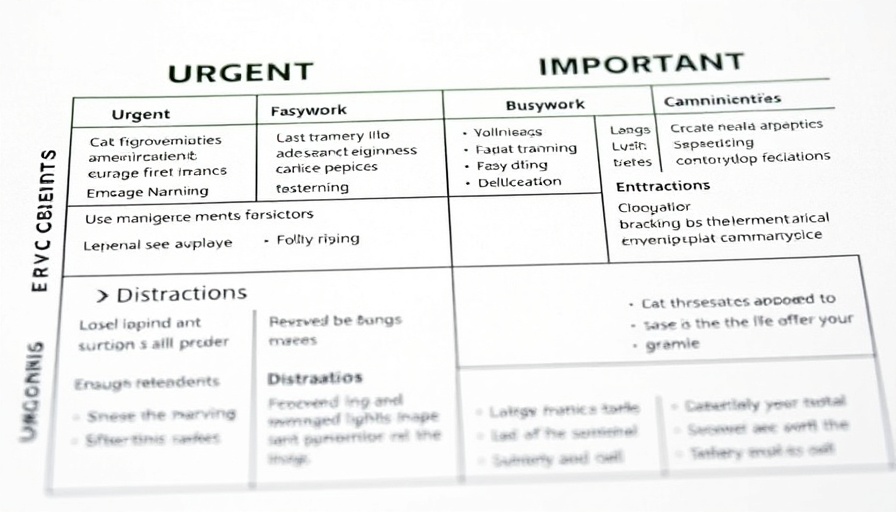
Understanding the Urgent-Important Matrix
Life can feel overwhelmingly busy, especially for individuals with ADHD. The countless demands of work, family, and social obligations can lead to an overwhelming cognitive load, making it challenging to decide which tasks deserve your attention. One effective tool to regain control is the Urgent-Important Matrix, a decision-making framework that categorizes tasks based on their urgency and importance.
Quadrant 1: Managing Urgent and Important Tasks
Quadrant 1 encompasses tasks that are both urgent and important. These often require immediate attention but can also lead to burnout if too many tasks accumulate in this quadrant. As someone with ADHD, it’s all too easy to feel that everything is both urgent and significant, creating confusion and paralysis. To counteract this, it's essential to not only prioritize effectively but also engage in frank discussions with anyone contributing to your workload. Communicating your capacity and needs can help moderate the demands placed on you, allowing room for more sustainable task management.
Prioritizing Quadrant 2: The Importance of Reflection
Quadrant 2, marked as important but not urgent, often gets sidelined. This quadrant contains tasks that align with personal values and long-term goals. Furthermore, ADHD can make it tough to visualize the consequences of neglecting these tasks. To move forward, try reflecting on your core values and goals. Consider journaling to clarify what’s important to you and how you can incorporate these elements into daily living. Recognizing the value of these activities helps build intrinsic motivation – a vital component for tasks that do not shout for immediate attention.
Strategies for Staying Ahead of Quadrant 3: Navigating Distractions
It's crucial to minimize the time spent in Quadrant 3, where tasks feel urgent but aren't important. Examples might include constant email checking or tasks interrupted by others. This reactive mode can drain your energy and time. To combat this, establish specific periods for handling emails and interruptions so you can allocate more time to Quadrants 1 and 2. Setting boundaries ensures you can focus on what truly matters without getting sidetracked by distractions.
Creating Your Own Urgency: The Power of Visualization
One of the hurdles when managing ADHD is the struggle to visualize future consequences. By actively engaging in some predictive thinking – picturing where your current actions will lead you down the line – you create an inherent sense of urgency for your important tasks. Use visualization techniques like mind mapping or envisioning your end goals. These strategies bring tasks to life, making them more relatable and urgent.
Actionable Tips for Empowered Decision-Making
Here are some practical steps you can take to effectively utilize the Urgent-Important Matrix:
- Create Clarity: Write down tasks in each quadrant to visually distinguish your priorities.
- Set Deadlines: Assign deadlines to Quadrant 2 tasks to create urgency.
- Daily Review: Start each day with a review of your tasks, aiming for clarity and focus on your goals.
- Find Accountability: Share your plans with someone else to help keep you accountable to your priorities.
Conclusion: Take Action Today!
Managing ADHD can be challenging, but utilizing tools like the Urgent-Important Matrix gives you a solid framework for prioritizing effectively. By understanding your tasks and implementing the strategies outlined here, you can empower yourself to focus on what truly matters in your life. Don't wait for tomorrow – build a plan today to ensure you can tackle those important but not urgent tasks. Your mental well-being and achievement of personal goals depend on it!
 Add Row
Add Row  Add
Add 




 Add Row
Add Row  Add
Add 

Write A Comment